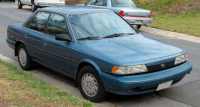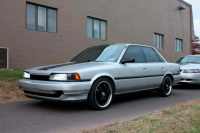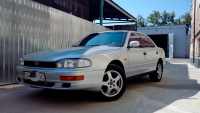The 1991 Toyota Camry had the body marking XV10. At first, it was produced exclusively as a sedan and was called Scepter. However, in 1992, also launched the production of a station wagon body, which had in its name another word - "Gracia". Under its own label, the Toyota Camry went for export in 1993. However, these versions were somewhat broader than what Japan was making for the domestic market. Then there was a situation that at the same time there was production of two types of cars under the same name.
The passenger car Toyota Camry of 1991 model year was supplied to customers with sedan, coupe and station wagon bodies, there was a modification Scepter for the Japanese domestic market. Vehicles of XV10 generation were produced at several plants, totally up to 100 thousand copies were made. The last trucks were produced in 1996, but these trucks are still in use and can be found on the secondary market. Vehicle equipment in the XV10
Vehicle equipment in the XV10
The 1991 model year Toyota Camry was produced in three versions:
2-liter on automatic transmission (four-speed);
2-liter on manual transmission (five-speed);
3-liter automatic transmission (four-speed).
The lower horsepower versions had 136 horsepower. The stronger units had 188 hp. The car is a four-door family sedan with a gasoline engine. First 100 km / h car develops for 9.7 seconds, with a mixed cycle fuel consumed at a rate of 8.5 liters per hundred kilometers.
The front wheel drive model was equipped with two types of braking system. Disc brakes were installed in the front, while the rear was equipped with drum brakes.
In terms of size, the 1995 Toyota Camry and older did not go beyond the usual family cars. The body length of 4730 mm fully met the requirements of comfort and the best aerodynamic properties. Width of Japanese version was 1770 mm. In terms of height, it had 1440 mm, which has passed on to the next generations. For the body XV10 Toyota Camry 1995 was the last year when the brand had a weight of 1360 kg. The next generations were already heavier by at least 40 kg.
Exterior description of the '91 car The 1991 Camry is equipped with an all-metal body with an extended engine compartment. Narrow block headlights with plastic scattering elements and plastic bumpers painted in body color are used. The windshield has an increased angle of inclination, which allowed to reduce aerodynamic drag and fuel consumption. Base versions are equipped with stamped wheels with decorative hubcaps of gray plastic, some modifications received original rims of aluminum alloy. At the rear, there are large combination lights, and on the trunk lid of cars for the U.S. market is a bridge made of plastic, which connects the lighting equipment in a single unit. After the 1995 restyling, the trunk lid surround was changed and the taillights received a different configuration. On cars with a wagon body, the rear lights differ from the configuration used on sedans. The XV10 generation is characterized by the division of the rear lights into sections, which are located on the wings and lid of the trunk. Cars for the North American market are distinguished by the rear bumper, which has a notch for the license plate. Cars for Europe had a flat bumper with the license plate mounted on the trunk lid. Because of this, the one-piece plastic lintel has a tear in the center. Some European and American versions used a black spoiler mounted on the trunk lid (for sedan versions). The trucks were equipped with power bars in the doors and adjustable steering column. The standard equipment included radio and cassette player, while later versions received CD player. The rear sofa has a split backrest and a fuel tank with a capacity of 70 liters is located under the bed.
The 1991 Camry is equipped with an all-metal body with an extended engine compartment. Narrow block headlights with plastic scattering elements and plastic bumpers painted in body color are used. The windshield has an increased angle of inclination, which allowed to reduce aerodynamic drag and fuel consumption. Base versions are equipped with stamped wheels with decorative hubcaps of gray plastic, some modifications received original rims of aluminum alloy. At the rear, there are large combination lights, and on the trunk lid of cars for the U.S. market is a bridge made of plastic, which connects the lighting equipment in a single unit. After the 1995 restyling, the trunk lid surround was changed and the taillights received a different configuration. On cars with a wagon body, the rear lights differ from the configuration used on sedans. The XV10 generation is characterized by the division of the rear lights into sections, which are located on the wings and lid of the trunk. Cars for the North American market are distinguished by the rear bumper, which has a notch for the license plate. Cars for Europe had a flat bumper with the license plate mounted on the trunk lid. Because of this, the one-piece plastic lintel has a tear in the center. Some European and American versions used a black spoiler mounted on the trunk lid (for sedan versions). The trucks were equipped with power bars in the doors and adjustable steering column. The standard equipment included radio and cassette player, while later versions received CD player. The rear sofa has a split backrest and a fuel tank with a capacity of 70 liters is located under the bed.
Weight and dimensions of Toyota Camry
Dimensions and weight characteristics of the car (version with a sedan body):
wheelbase - 2620 mm;
length - 4780 mm;
width (without taking into account mirror housings) - 1770 mm;
height - 1410 mm;
track width in front and rear - 1549 and 1599 mm;
curb weight (depending on the type of engine and gearbox) - from 1355 to 1475 kg;
Payload - up to 475 kg.
Advantages and disadvantages
The main advantages of the car are:
low noise level in the cabin;
comfortable suspension;
simple design of the running gear and transmission units;
reliability of the engines (service life up to overhaul exceeds 500 thousand km);
spacious interior;
high quality of the interior materials.
Disadvantages of XV10 generation Camry:
increased fuel consumption;
clouding of plastic headlights from time and under the influence of sand and dirt;
Corrosion of body elements due to the age of cars;
low ground clearance due to the unfortunate location of the exhaust system.
Test Drive Results
The first test drive of the car was conducted in 1992 by journalist Chris Goffey, who collaborated with Top Gear. For the test drive a version with 185 hp engine and automatic transmission was chosen. During the tests, the journalist noted the low noise level in the cabin and the absence of vibrations on the seat cushions and controls. The sedan's advantages were increased roominess (in comparison with Corolla) and high dynamic characteristics (e.g., acceleration from a place up to 60 mph took 7.8 seconds on an average).
The original cooling system with a hydraulic fan control clutch was noted. An electronic unit turns the impeller on and off based on data from sensors mounted on the motor and gearbox. The height-adjustable seat belts and adjustable lumbar support in the front seat backs have been added to the advantages of the car. Increased interior dimensions and suspension, which ensured the car's stability while driving at high speeds, were also noted.
Modern operation For comfortable operation today, the car of the late 20th century needs to change a lot of running units. Age-old Camry often jams the CPS, it is necessary to monitor the suspension all the time, as it wears out quite quickly, especially in older devices of mechanisms. In addition, over time, some of the rubber hoses may fail due to the loss of their elasticity.
For comfortable operation today, the car of the late 20th century needs to change a lot of running units. Age-old Camry often jams the CPS, it is necessary to monitor the suspension all the time, as it wears out quite quickly, especially in older devices of mechanisms. In addition, over time, some of the rubber hoses may fail due to the loss of their elasticity.


-rear-and-front-view-camera-6.png)

